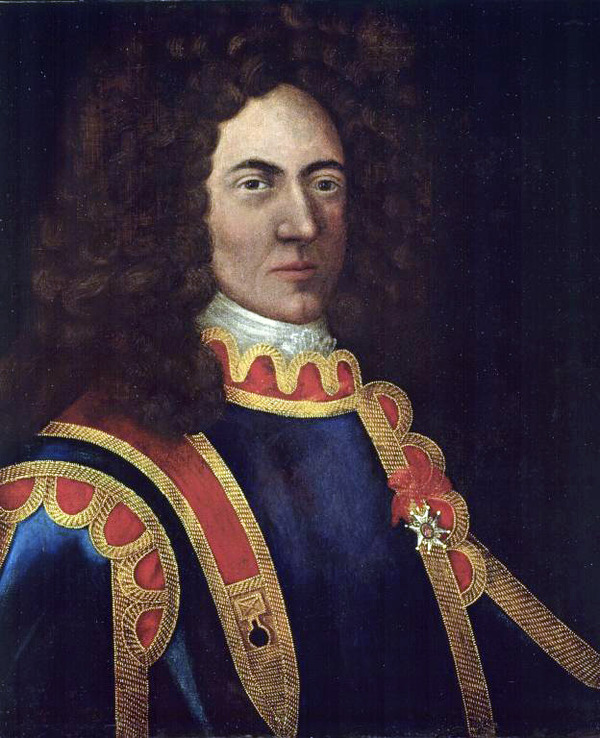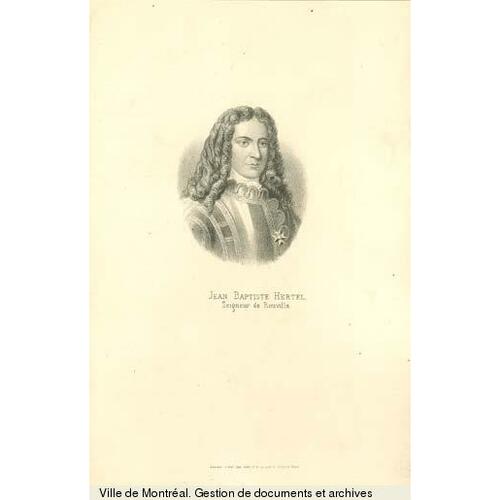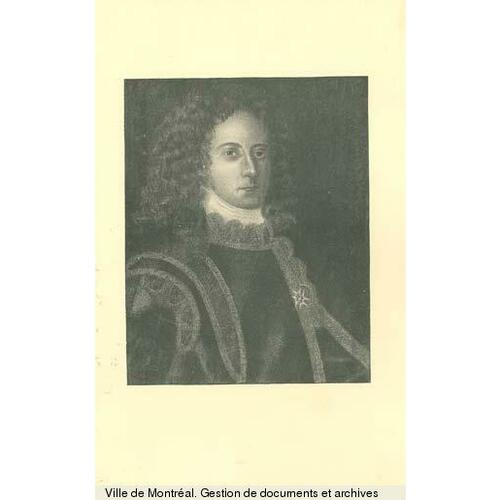
Source: Courtesy of Wikimedia Commons
HERTEL DE ROUVILLE, JEAN-BAPTISTE, ensign, lieutenant, captain on Île Royale (Cape Breton Island), commandant of Port-Dauphin (Englishtown, N.S.), knight of the order of Saint-Louis; b. 26 Oct. 1668 at Trois-Rivières, third son of François Hertel and Marguerite de Thavenet; buried 30 June 1722 on Île Royale.
Like all the members of his family, Hertel de Rouville took up soldiering at an early age. He had already gained some experience in a number of skirmishes before he accompanied his father and two of his brothers in Governor Brisay de Denonville’s campaign against the Senecas in 1687. He was also on the expedition led by his father which razed the village of Salmon Falls in the winter 1690–91, and a few months later he helped in the resistance that Quebec put up against Phips*. When he had barely reached his majority he was already fit to command the surprise attacks of which his father had perfected the tactics.
The first important raid directed by Hertel de Rouville occurred in 1704, and took the same form as the one against Salmon Falls in which he had participated 13 years before, except that the party was larger: 250 men, of whom 50 were Canadians and 200 were Abenaki and Iroquois Indians from Sault-Saint-Louis (Caughnawaga). This time it was a question of avenging the Abenakis, who had just been the victims of a bloody raid and who had asked Rigaud de Vaudreuil for help. Among the French volunteers were four of the commander’s brothers. The expedition had no precise objective; the intention was to make reprisals. Fate willed that the target should be the little town of Deerfield, on the outskirts of which the assailants arrived in the night of 28–29 February (10–11 March, n.s.). Thanks to the snow piled up along the stockades they slipped silently inside and the massacre began: 54 settlers were killed (Bancroft puts it at 47) and about 120 were taken prisoner. The latter included the minister John Williams, whose wife had been killed in the raid, and three of his children. On the French side there were three dead and some 20 wounded, among them Rouville himself. In the autumn of the same year Hertel de Rouville was in command of a group of Abenakis at Placentia (Plaisance), where he went to give assistance to Auger de Subercase. At that time he took possession of an English fort.
Four years later, in 1708, the governor put Rouville and Jean-Baptiste de Saint-Ours* Deschaillons in command of an expedition of the same type. The objective this time was to be the seaport of Portsmouth (N.H.). When an epidemic broke out among the allied Indians, they took this as a bad omen and at the last minute refused to join the expedition. With barely 200 fighting men, the commanders deemed it unwise to attack the fortified post, and chose the harmless little village of Haverhill on the Merrimack River. The church and surrounding houses were burned down and some 15 people killed, including the minister Benjamin Rolfe and his wife. On their way back the small party, delayed by its prisoners (the majority women, old men, and children), was attacked by a detachment led by Captain Ayer. A fight took place, and the French forced the enemy to flee. Among the dead were Pierre Jarret de Verchères and René Hertel de Chambly, Hertel de Rouville’s brother. Another Verchères, Louis, was taken prisoner.
In the summer of 1709, at the request of Vaudreuil and of the allied Indians who had specifically asked for him as their leader, Hertel directed another raid on the outskirts of Deerfield, to forestall a possible attack against Montreal. The English losses amounted to several dead and two men who were made prisoner, John Arms and his brother-in-law Joseph Closson, who were taken to Sault-Saint-Louis and condemned to run the gauntlet, a great attraction for the Indians. The French authorities vainly tried to exchange Arms, an officer, for Verchères, an ensign; the English reserved the right to exchange the latter for a daughter of the minister Williams.
Joseph Dudley, the governor of Boston, sought to make a compromise with Vaudreuil. There were several exchanges of prisoners, but the threat of reprisals was in the air. For some time every village in New England was on the alert. This was what the French authorities, who it must be said treated the English prisoners humanely, were after. Hertel de Rouville and his men had become the terror of the soldiers and settlers. Prodigious bravery and speed of execution had done much to create the reputation of a great warrior that was attached to the name Hertel de Rouville. It must be admitted, however, that his most impressive exploits had been accomplished against defenceless people, and that to preserve the goodwill of his Indian allies he had been constrained to permit the carrying out of acts of barbarity that were unworthy of civilized beings. On the other hand, the psychological effect of these unexpected attacks was considerable. It is understandable that this commander, trained in Indian methods of combat, was never favourably reported on by the English chroniclers and historians who have recounted these events. Ansel Phelps describes him thus: “An officer of great courage, but pre-eminently cruel and vindictive.” Relating the massacre at Haverhill, George Wingate Chase speaks of “the infamous Hertel de Rouville, the sacker of Deerfield.”
Subsequently the authorities tried to entrust Hertel with quieter missions, for his health no longer allowed him to make spectacular excursions. In 1710 he was sent as a representative to Boston with one of his most loyal lieutenants, Simon Dupuy, to try to settle the details of certain agreements with the English leaders. On 24 Feb. 1713 the minister of Marine instructed M. de Vaudreuil to select “40 or 50 of the best workers” in New France and to send them to Cape Breton Island to work on the fortifications there; in this activity they were to be under the command of the Sieur Hertel de Rouville. The latter went there with his family, which he housed at Port-Toulouse (St Peters). He signed with the other officers the act authorizing the taking over of the island. The following year Governor Pastour de Costebelle sent him, with Captain Louis Denys* de La Ronde and the engineer Jean-Baptiste de Couagne, to explore the island’s north shore. In 1715, on the strength of the report he had submitted, Rouville received orders to take his men to Port-Dauphin to build a fortress there, containing a warehouse, a forge, a bakery, barracks, and a hospital. The work was pushed ahead briskly and completed before winter; this won Rouville the esteem of the island’s governor, who called him a “phoenix of toil.”
The establishments on Cape Breton Island were designed primarily for defence, and Hertel de Rouville was a man who preferred taking the offensive. The authorities realized this, and on 14 Oct. 1716 Vaudreuil asked the council of Marine to send him back to New France, “Because he does not know anybody better fitted to be sent among these Indian nations . . . both because of the ascendancy that he has over these nations and furthermore because he is capable of opposing all the ventures that the English might undertake in this part of the continent.” The council yielded to the governor’s request, and Rouville was informed of it on 7 July 1717. But the order was countermanded, for an English attack from the direction of Acadia was anticipated, and Rouville’s presence was thought to be likely to give the enemy pause. In 1719 he went to France to raise a contingent to reinforce the Port-Dauphin garrison. He was still commandant of this fort when he died prematurely, at the age of 54. He was buried on 30 June 1722, about a month after his father.
Hertel de Rouville had been made a knight of the order of Saint-Louis on 23 Dec. 1721, a few months before his death. He had been married twice. On 23 Nov. 1698, at Trois-Rivières, he had married Jeanne Dubois, who died less than two years later. On 6 Feb. 1708 he married Marie-Anne Baudouin, the eldest daughter of the Quebec doctor Gervais Baudouin*. The marriage contract, drawn up two days earlier by the notary Genaple, had been the occasion for an impressive ceremony in the residence of the intendants, Jacques and Antoine-Denis Raudot, in the presence of Governor Vaudreuil, his wife, and the principal civil and military figures of the town. Several children were born of this union, among them Jean-Baptiste-François, who like his father took up a military career, and was made a knight of the order of Saint-Louis in 1762, and René-Ovide*, born 6 Sept. 1720 at Port-Toulouse, who became a judge, and to his mother’s despair had married the flighty Louise-Catherine André* de Leigne.
On 8 Jan. 1694 Hertel de Rouville had obtained from Governor Buade* de Frontenac a seigneury adjoining his father’s, to which he gave his name. One can understand why he was never able to develop it. Before he left for Acadia he had decided to reside at Montreal, in a house in Rue Saint-Paul which Madame Baudouin had given her daughter as a marriage settlement. In 1724 his widow rendered fealty and homage to the governor for the Rouville seigneury, and at the same time obtained a gratuity of 300 livres paid out of the royal treasury, “in consideration of her husband’s services. “
For more complete bibliographical information, see Joseph-François Hertel de La Fresnière. AJQ, Greffe de François Genaple, 4 févr. 1708. Coll. de manuscrits relatifs à la N.-F., I, 455–61, 497f. “Correspondance de Vaudreuil,” APQ Rapport, 1938–39, 28, 43, 44, 54, 56, 62; 1939–40, 428, 431f.; 1942–43, 428, 429; 1947–48, 151, 167, 196, 197, 228, 327, 334. Fauteux, Les chevaliers de Saint-Louis. Albert Gravel, Pages d’histoire régionale (Sherbrooke, 1966).
Cite This Article
Raymond Douville, “HERTEL DE ROUVILLE, JEAN-BAPTISTE,” in Dictionary of Canadian Biography, vol. 2, University of Toronto/Université Laval, 2003–, accessed January 1, 2026, https://www.biographi.ca/en/bio/hertel_de_rouville_jean_baptiste_2E.html.
The citation above shows the format for footnotes and endnotes according to the Chicago manual of style (16th edition). Information to be used in other citation formats:
| Permalink: | https://www.biographi.ca/en/bio/hertel_de_rouville_jean_baptiste_2E.html |
| Author of Article: | Raymond Douville |
| Title of Article: | HERTEL DE ROUVILLE, JEAN-BAPTISTE |
| Publication Name: | Dictionary of Canadian Biography, vol. 2 |
| Publisher: | University of Toronto/Université Laval |
| Year of publication: | 1969 |
| Year of revision: | 1982 |
| Access Date: | January 1, 2026 |





